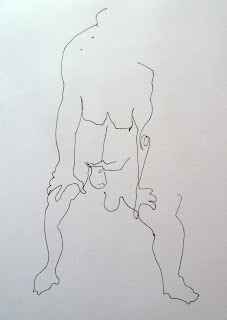Exploring Concepts
Assignment 2
The Figure and the Self Portrait
Self-Portrait
Gianni Maimeri’s Woman Seated particularly appealed to me as the flesh tones have a pearly quality to them, the portrait is understated and the stronger for that, so I tried to emulate the quiet thoughtful nature of the sitter, and the skin tones he used. I also liked the verticals he used in the background. He uses very muted colours and part of the background is almost black. As his model is front lit this was not a problem but with my own backlit view, it was important to indicate a light source. Because my light source is a North light, the skin tones are very similar to those used in Maimeri’s painting. I used oil for this portrait.
The quirky feature which is most noticeable is the raised eyebrow, it is an unconscious feature of my face, as well as my particularly small ears.
I was glad to have the opportunity of introducing some counter-change with the self portrait, which adds interest to the painting and I think the subtle north light makes for a softer portrait than stronger lighting.
I was also influenced by Peter Kuhfeld and like the way he often uses backlight for his models. His brushwork is spontaneous and in my full length portrait I have tried to apply his almost impressionistic style to the work. In my mind as I worked on the floor I was thinking of Caillebotte’s beautiful painting The Scrapers.
I feel the overall colour scheme works well and the items in the background do not dominate the portrait. I believe it was Franz Marc who said that “yellow and blue love each other”. In this painting I have used the contrasts of purple and yellow as well as blue. I have also used right angle repetitions in the arms, legs and the pictures on the wall. The bend of the leg echoes the foot of the easel and is obliquely opposite to the angle-poise lamp in the background. I think the gaze is both concentrating and exploring at the same time and the moment is captured when one stops to look at a particular detail you are trying to capture.
Again this is a north light with light bouncing off the mirror on to the face, so the flesh tones are fairly subtle, and the atmosphere in the room is one of cool North light which keeps the colours in the cooler spectrum. I used acrylic paints for this portrait.
Again this is a north light with light bouncing off the mirror on to the face, so the flesh tones are fairly subtle, and the atmosphere in the room is one of cool North light which keeps the colours in the cooler spectrum. I used acrylic paints for this portrait.
Check and Log
- How have you used the texture of the paint in your work?
I would like to think I have used the texture subtly, these are not impasto paintings but the texture of the paint has been expressed through the brushwork.
- Were you able to capture a likeness of yourself?
I believe I have in both cases, though of course as with all self portraits the look is stern and I would like to think I do not always look as stern. However, in sketches that I did, I have captured angry/depressed looks.
- Do your portraits have a sense of space and depth?
There is a sense of space in the self portrait though not a lot of depth, there is more depth in the full length portrait, because of the use of perspective lines, particularly on the floor.
- What aspects of your work do you think you need to focus on? Is there anything you wish to discuss with your tutor?
I think I need to continue to think about spontaneity in my work, which has been helped by the earlier exercises. As I feel more confident about achieving this I will concentrate more on composition and the important elements that help to make a painting work, as written by Bernard Dunstan in his book entitled Composition. Some of these elements may not be relevant to modern ways of composing pictures, particularly abstract ideas, but others may well be relevant. I have used one of the suggestions, spilling warm colours into cool colours of similar tones, for example in the floor on the right of the full length painting.




























